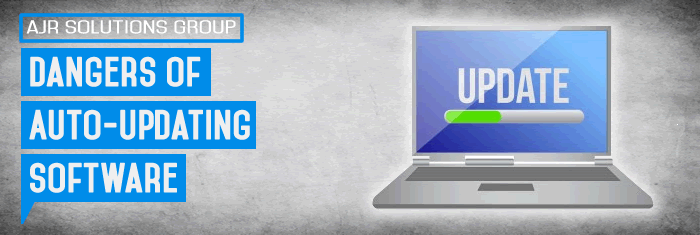In this article AJR discuss – Dangers of Auto-Updating Software
In a business IT environment, the issue of software upgrades is far more important than for virtually every consumer. There are many reasons for this. One is simply the sheer number of computers that need to be upgraded, meaning that an upgrade error will affect hundreds or even thousands of users. Another is the impact upgrading can have on training if a number of important changes are involved. The bottom line for the business is the bottom line.
Auto Updating
When a business uses the auto upgrade option, it turns over control of the security and functionality of the software to the company that developed it. There are many cases where this has gone particularly wrong, such as McAfee’s upgrade several years ago where companies and academic institutions were left wide open to hacker attacks when the company accidentally distributed the wrong upgrade to its users. Fortunately, the error was discovered within hours and any damage incurred was minimal.
This is an example of when software that is essential for the security of your company’s data and day-to-day operations can create an untold number of in-house headaches, sucking up valuable time that will result in plummeting productivity. In this particular scenario, it is important for businesses to carefully read that document so many hope to avoid – the End User License Agreement or EULA. Pay particular attention to the legal remedies available to you should a software upgrade go awry.
Update Failure
The business-as-usual model says that if something can go wrong, it will. When an update fails in its installation or something goes wrong in-house, a rollback of the entire system quite probably has to take place. Should this happen, the wrath of every department will come raining down on IT because they are supposed to know better. But taking responsibility for another company’s mistake, in this case the distributor of the upgrade, is likely not compensated for in the EULA. The bigger problem is that even if management accepts that the failure is not the fault of IT, there are going to be a lot of questions to be answered about the IT decision making processes.
The Broader Impact
Depending on the type of update, installation may require other software applications to be tested before resuming business as usual. This will likely involve some degree of downtime for the users. Auto updating squashes the possibility of scheduling the update at a time convenient for the business. Even if the software allows scheduling the update, technical glitches at the updating site can result in delaying installation of critical updates for a period of time. If a company schedules the update to be performed on a Saturday at 10 a.m., IT staff and others must be on site. A failed installation will cost the company time and money and may delay the update for another week – the following Saturday. If it is a security update there will likely be a few nervous people carefully watching the application for the week.
Some companies do not like to upgrade their software because the reasons for the upgrade are not relevant to their specific business. Auto updating takes this option away, again potentially costing the company time and money. The problem with not choosing auto updates is that companies need to remember to regularly check to see if one is available. The end of the story seems to be, the fewer updates that are necessary, the better the software.



